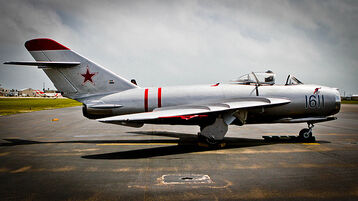No edit summary |
(Adding categories) Tag: categoryselect |
||
| Line 38: | Line 38: | ||
[[Category:Cold War]] |
[[Category:Cold War]] |
||
[[Category:Korean War aircraft]] |
[[Category:Korean War aircraft]] |
||
| + | [[Category:Single-engine aircraft]] |
||
Revision as of 06:19, 2 July 2016

The Mikoyan-Gurevich MiG 15 (NATO reporting name: "Fagot") was a Soviet jet fighter first flown in 1947 that made its combat debut during the Korean War. It was a single-engine, short range interceptor/fighter.
The MiG-15 featured the first production swept-wing on a Russian aircraft, the first pressurized cockpit, and the first ejection seat.
Over 7,500 were built.
Development
Design work on the MiG-15 began in March 1946, following the issuing of a Kremlin requirement for a jet fighter capable of reaching transonic speeds. As the only jet engines available to the Soviets at the time, the BMW 003 and Jumo 004, were incapable of providing the power required, a number of Soviet power-plant engineers were dispatched to the UK, to study Rolls-Royce Derwent and Nene engines at first hand. This led to the sale of 10 Nenes in September 1946, with another 15 following in March 1947. These were reversed engineered as the RD-45, and selected to power MiG's new transonic fighter, known to the company as the I-310, or simply the S. This featured a simple fuselage with the engine buried in the rear below a T-tail, and aspirated via a bifurcated intake in the nose.[1]
Three prototype were constructed, with the first making the type's initial flight in the hands of Viktor Yuganov on 30th December 1947. The Kremlin ordered the type into full scale production as the MiG-15 shortly after the start of flight testing, which led to a number of changes,

such as the shortening of the tail pipe. Yuganov also made the initial flight of the first production example, which took place on 30th December 1948, with the type entering service in January 1949. The RD-45 engines in early aircraft was replaced by the more reliable RD-45F, which was refined into the more powerful VK-1. The armament was also upgraded, with the NS-23 23 mm cannon being replaced by NR-23s, followed by replacement of the NS-37 with the N-37.[1]
In 1948 a two seat trainer version was developed, known as the ST/I-312T. The prototype of this version first flew in January 1949, with production MiG-15UTIs being delivered during the spring. The Trainer versions received the NATO codename 'Midget'.[1]
Operating History
In 1950, MiG-15s piloted by Russians appeared over North Korea and were shockingly successful at downing first-generation American jets such as the P-80 and F-84. In order to establish air superiority, the USAF rushed the F-86 Sabre into the war. In this plane the best aces of the Korean War (Nicolai Sutiagyn and Yevgheni Pepelayev) humiliated the United States Air Force.
Taking note of the plane's heavy losses against the newer USAF fighters, Soviet Air Force rapidly redesigned the MiG 15 into the more advanced MiG-17.
Details:
- Length: 33 ft, 4 in
- Wingspan: 33 ft, 3 in
- Wing Area: 221.8 ft
- Instantanious Turning Capability: 18°-20°/second
- Sustained Turn Capability: 10°-12°/second
- Maximum Speed (I-310): 647 mph
- Rate of Climb (I-310): 16,402 ft in 2 minutes 18 seconds